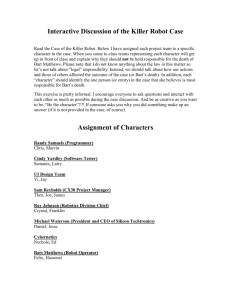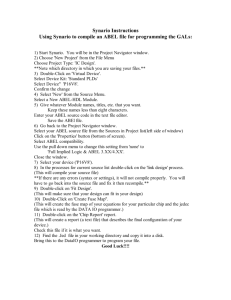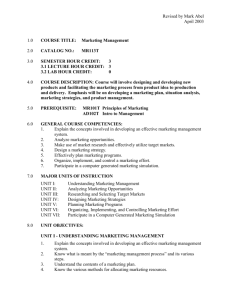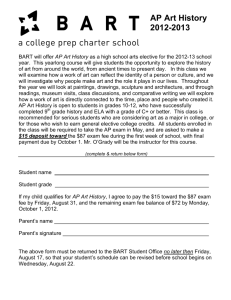ASSIGNMENT #3. DUE ON NOVEMBER 22. COVER PAGE UNIVERSITY OF TORONTO
advertisement
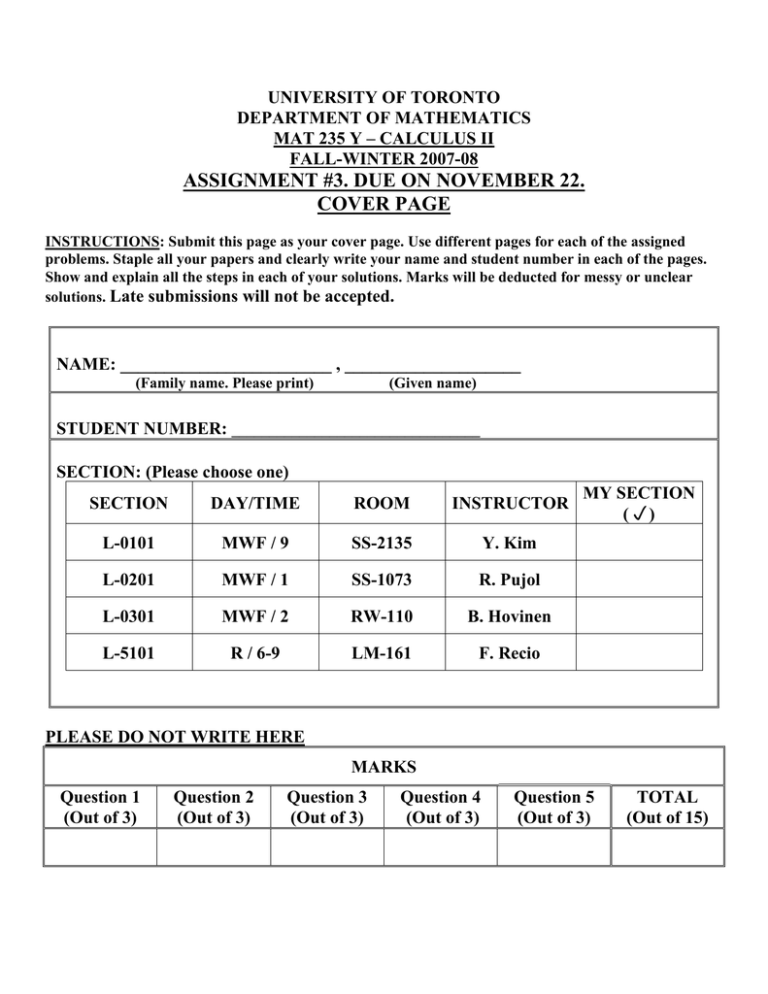
UNIVERSITY OF TORONTO DEPARTMENT OF MATHEMATICS MAT 235 Y – CALCULUS II FALL-WINTER 2007-08 ASSIGNMENT #3. DUE ON NOVEMBER 22. COVER PAGE INSTRUCTIONS: Submit this page as your cover page. Use different pages for each of the assigned problems. Staple all your papers and clearly write your name and student number in each of the pages. Show and explain all the steps in each of your solutions. Marks will be deducted for messy or unclear solutions. Late submissions will not be accepted. NAME: ________________________ , ____________________ (Family name. Please print) (Given name) STUDENT NUMBER: _________________________________ SECTION: (Please choose one) SECTION DAY/TIME ROOM INSTRUCTOR L-0101 MWF / 9 SS-2135 Y. Kim L-0201 MWF / 1 SS-1073 R. Pujol L-0301 MWF / 2 RW-110 B. Hovinen L-5101 R / 6-9 LM-161 F. Recio MY SECTION (R ) PLEASE DO NOT WRITE HERE MARKS Question 1 (Out of 3) Question 2 (Out of 3) Question 3 (Out of 3) Question 4 (Out of 3) Question 5 (Out of 3) TOTAL (Out of 15) MAT235Y Problem Set 3 Due 22 November 2007 1. A trip through the mountains Bill and Jane are attending a math conference in the mountains (For some unknown reason, math conferences tend to be held in mountainous areas in the middle of nowhere. It remains one of life’s great mysteries.), taking a walk through some rough terrain. It’s getting cold and dark and they decide that they should head back to the conference centre. But they need to decide on a good route. Being good mathematicians, they have approximated the terrain as a bivariate function. If F (x, y) is the function that assigns to the point (x, y) the elevation of the ground at that point, then F (x, y) = 4e−(x/4) 2 −(y/4)2 . (a) Jane is concerned that it’s getting cold. Thinking about how this might affect their trip back to the conference centre, Bill suggests modelling the temperature in the following way: • The temperature at the point (0,0,0) is 15 degrees C. It falls by one degree for every unit of elevation. • It is slightly warmer to the northwest: on level terrain, the temperature at elevation zero varies linearly with the x and y coordinates in such a way that it decreases by five degrees C for each unit in the positive x direction and by one degree C for each unit in the positive y direction. • The temperature is then determined by the sum of the effects of elevation and of position. Write down the definition of T (x, y), which assigns to the point (x, y) the temperature at that point. (b) Now let’s suppose that Bill and Jane are at point (5,-1) and walk due westwards (i.e. parallel 1 to the x axis in the negative direction). How quickly will the temperature that they experience change as they start walking? (c) Bill does not want to ascend at a rate of more than one unit for each two units of distance, nor to descend at a rate of more than one metre for every one metre of distance. If they keep walking westwards, will they encounter difficulties with the terrain? (d) In what direction should Bill and Jane begin to walk in order that the temperature initially rise most quickly? 2. A mad scientist’s architectural creation The mad scientist Dr. Nenivoh, working on contract with Vandelay Industries, Inc. just designed a new Museum of Geometric Paradoxes, to be filled with exhibitions of surfaces that can’t actually exist in our universe. In a feat of brilliance, he decided that the roof profile of the museum should be the set of points satisfying the equation x2 = y 2 z 2 − z 3 , where z is the vertical axis and x and y are the horizontal axes. The coordinates are such that the ground is the plane z = −5. His assistant, Dr. Oicer, then reminded him that their clients wanted an antenna pointed straight up at a place where it would be orthgonal to the surface of the building. (a) Is there any suitable location for the antenna? (b) Upon reviewing the specifications, Vandelay Industries determined that the antenna should in fact not point straight up but should instead be 30 degrees from the vertical, oriented in the positive y direction. It should still be situated so as to be orthogonal to the surface of the roof. Where on the surface should the antenna go? 3. The heat equation In this problem we will study the evolution of the temperature in a one-dimensional rod with time. Suppose that the rod is embedded in R as the interval [0, 1]. Denote by u(t, x) the temperature at time t of the point x. We can determine u using a partial differential equation that relates ut := uxx := 2 ∂ ∂t2 u. ∂ ∂t u with Namely, ut = kuxx . (1) The parameter k is a constant depending on the material, called thermal conductance. (a) Let u(0, x) = sin(πx). Describe in words how the temperature is distributed in the body at time t = 0. 2 (b) Verify that u(t, x) = sin(πx)e−π 2 kt is a solution to equation (1) and that u(0, x) = sin(πx). (c) Define F (t, x) := |ux (t, x)|. Using the solution u above, write down a formula for F (t, x). (d) Describe (with justification) the behaviour of F as t → ∞. Explain in words what this means. 4. Reflection properties (a) Prove the following reflection property of prolate spheroids: Given an ellipsoid embedded in space o n 2 2 2 as (x, y, z) ∈ R3 | xa2 + ay2 + zc2 = 1 with c > a (note the middle term!), show that there exist two points F1 and F2 (the foci ) on the interior of the ellipsoid such that a particle ejected from F1 in any direction will bounce off the surface of the ellipsoid in such a manner that it will hit F2 . n o 2 2 2 (b) Does the same property hold for arbitrary ellipsoids (x, y, z) ∈ R3 | xa2 + yb2 + zc2 = 1 ? 5. Knowing how to set prices The owners of two stores, Abel’s Widgets and Gadgets and Bart’s (highly sophistimicated) Doohickeys and Thingamajigs, are both excited about the pending release of Mad Scientist Inc.’s new X-120 brand widgets. If the press releases and industry hype surrounding the X-120 is any indication, they’ll sell like hotcakes. Abel and Bart are competing and each wants to maximize his revenues. They’re very dilligent people and have done a lot of market research on both their own markets and their competitor’s markets. In particular, they each know the following: • Initially, 1000 people are planning to buy the X-120 from Bart and 800 from Abel. • However, some of the people buying from Bart will be persuaded to buy instead from Abel if Abel offers a lower price, and vice versa. For each $1 increase in the price difference, one more person will switch from the store with a higher price to the store with a lower price. • They each get some foot traffic by their respective stores, so impulse buyers will buy from them. If (hypothetically) Abel set his price at $100, then 700 impulse buyers would buy from him. Bart’s store is in an area with lower foot traffic, so if he set his price at $100, then only 500 impulse buyers would buy from him. • The number of impulse buyers falls linearly with the price. For each $1 increase in price, both Abel and Bart receive 5 fewer impulse buyers. The question is: How should Abel and Bart set their prices? We’ll proceed in stages. 3 First, some notation: denote by pA the price that Abel charges and pB the price that Bart charges. Let πA be the revenue attained by Abel; it is a function of both pA (obviously) and pB (since that affects the number of customers Abel gets). Similarly, let πB be the revenue attained by Bart. (a) Write down the defining equations for πA (pA , pB ) and πB (pA , pB ). What are (within reason) the domains of πA and πB ? (b) Both Abel and Bart are pretty intelligent people. Each wants to maximize his revenues and each knows that the other wants to do the same. Find values of pA and pB such that neither Abel nor Bart can increase his revenues by unilaterally deviating from those prices. This is called a Nash equilibrium 1 Hint: Think about maximizing πA and πB . (c) The product release date is approaching and Mad Scientist Inc. puts out a press release indicating pricing. The price of the X-120 brand widget is set at $175 for volumes of 100 or more. Does this change matters? If so, how? 1 The “Nash” is John Nash — the one from the movie “A Beautiful Mind”. His discovery and proof of existence of Nash equilibria is what got him the Nobel prize in economics. 4

